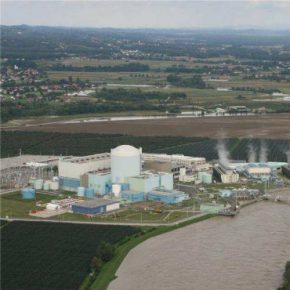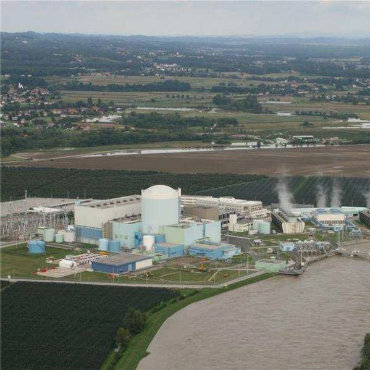
Krško nuclear power plant, Slovenia (slovenskavojska.si, CC BY 3.0)
Krško NPP provides a significant portion of Slovenian energy balance, and has been modernized several times. Currently is licensed until 2043. „Due to the changes that have occurred in the field of energy, Slovenia will soon have to decide the direction of development in this area. Slovenia is a nuclear state because we receive a considerable amount of energy from a nuclear power plant and we will feel its absence very soon,” said Slovenian PM Marjan Šarec.
Slovenian energy mix
A third of the electricity comes from the nuclear energy. The other two-thirds are hydro and thermal power plants, the largest of which, the TPP 3, due to negative economic balance and gas emissions, should be shut down at about the same time as the life of the Krško runs out, i.e. around 2043. „We need a serious energy policy with clearly set goals. We must put more efforts to achieve energy independence, when we do not want electricity from thermal power plants or other energy sources,” Mr. Šarec added, recalling the goals of reducing climate change and EU directives on energy. Mr. Šarec said that modernizing and increasing the NPP’s capacity would bring result comparable to ten hydro power plants.
Slovenia has advanced four places in the analysis of the WEC World Energy Council, as it’s ranked the sixth among the 125 countries, according to the World Energy Trilemma Index. The Energy Trilemma Index 2018 report evaluates the results and progress of countries in all elements of the so-called energy trilemmas, namely in the fields of energy security, energy availability and environmental sustainability. Production reliability and predictability of Krško NPP, its low carbon footprint and its low production cost are an effective answer to the energy trilemma questions posed by the modern world, or at least this is the opinion of both governments.
Slovenian government still has to adopt a national energy development plan, and the country needs a second nuclear unit to have enough electricity. „We must make every effort in building the second block because we will need more and more electricity, especially if we want to be a prosperous state,” said Mr. Šarec.
The second unit – yes or no?
The possible construction of the second unit of the Krško NPP has been debated for twenty years. There were preliminary talks with potential equipment suppliers and creditors, but they were more or less suspended a decade ago, at the time of the outbreak of the financial and economic crisis. At that time, a new unit in Krško was estimated to cost between EUR4-5bn. The 2018 was a success as all the key goals of Krško have been met. The plant’s management exceeded production and delivered 5,489,429 megawatt hours, which is 59,429 megawatt hours more than planned. In doing so, they generated revenues of EUR158.4m.
Energy experts that are in favor of building a second unit say that a decision should be made at least ten years before the planned closure of the old unit. On the other hand, those who oppose the prolongation of the current nuclear power plant and advocate for renewable energy, say that Slovenia should replace nuclear and fossil fuels and switch to renewable sources.
In the wake of 2012 Fukushima Daiichi disaster, the Krško NPP has been digitalising its processes as a part of safety upgrades. It was implemented in all areas and allows for optimal maintenance of the plant and gives lower operating costs. The high reliability and predictability of electricity produced in Krško is an exceptional added value to the energy systems of Slovenia and Croatia.
In October 2018, Nuclear Engineering International Journal published a comparison of annual production capacity indicators of 341 power plants worldwide. The Krško NPP was ranked 23rd. The indicator of production capacity is the ratio between the actual and the possible production of a power plant over a period of 12 months or during the total operating life. A factor of production capacity of 99.1 per cent, achieved by Krško, means high reliability and predictability of the produced electricity. According to the latest safety review, Krško NPP is listed in the first class of performance and is thus ranked among the most successful NPPs in the world.
Problem with the radioactive waste
But the nuclear plant also produces waste, which is temporarily stored in the power plant. But this temporary solution has been in effect for almost 36 years. Medium and low level radioactive waste will be stored within the nuclear power plant until 2025 at the latest. This year, 11 cubic meters of low-level radioactive waste has been stored so far. The preparation of a combustible, radioactive waste for incineration is underway. Incineration can result in up to 20 times less waste. The total volume of low- and intermediate-level radioactive waste at the end of 2017 was 2284 cubic meters. Over the last ten years, just over 30 cubic meters per year has been generated, which is quite small.
Slovenians have already chosen a location for their new warehouse, and it is up to Croatians to decide where to store half of their waste — in Croatia or whether they will pay Slovenia for doing so. The most striking solution to date has been the Tržna Mountain in Dvor, but the final choice is far from over. Croatian representative at the Nuclear Authority points out that the public is sensitive to this, and thus it’s a political decision. Despite the fact that it is a technologically trivial issue, for which there are simple, elegant and not expensive solutions.
Conflict with neighbors
Apart from finding investors for building and equipping the new unit, the Slovenian government also has a large problem with its northern neighbor. The announcement by Slovenian Prime Minister has provoked negative reactions in Austria, which gave up nuclear power and demanded the nuclear plant to be shut down in the 1990s. Reactions are particularly severe in the southern parts of Austria, the Carinthia and Styria regions. Deputy Styrian Land Chief, Michael Schickhofer said that construction of the second unit in Krško, after the current reactor will be shut down in 2043, was „unacceptable”.
Mr. Schickhofer also urged the Austrian federal government to respond promptly to Slovenian PM’s statements. „The nuclear plant in Krško should be closed today, not tomorrow, under no circumstances should the second block be built,” Mr. Schickhofer said, recalling some of the information that has been in Austria in recent years, that Krško is at a tectonic turning point so it is not safe in case of an earthquake. „We need a national and European alliance against nuclear power. We must unite all forces to prevent the spread of nuclear power plants,” Mr. Schickhofer added.


